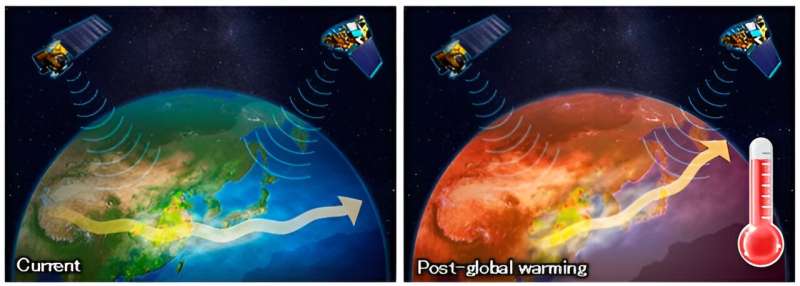This article has been reviewed according to Science X's editorial process and policies. Editors have highlighted the following attributes while ensuring the content's credibility:
fact-checked
peer-reviewed publication
trusted source
proofread
Detecting climate change using aerosols

Climate change is one of the most significant environmental challenges of present times, leading to extreme weather events, including droughts, forest fires, and floods. The primary driver of climate change is the release of greenhouse gases into the atmosphere due to human activities, which trap heat and raise Earth's temperature.
Aerosols (such as particulate matter, PM2.5) not only affect public health but also influence the Earth's climate by absorbing and scattering sunlight and altering cloud properties. Although future climate change predictions are being reported, it is possible that the impacts of climate change could be more severe than predicted. Therefore, it is necessary to detect climate change accurately and as early as possible.
Building on these insights, a research team from Japan, led by Professor Hitoshi Irie from the Center for Environmental Remote Sensing at Chiba University, utilized long-term observational data to study the effect of climate change on transboundary air pollution in the downwind area of China by using aerosols. They utilized a completely unique perspective on how aerosols impact the climate and developed a new metric to detect climate change by considering aerosols as tracers.
"The significance of this study lies in the fact that most of its results are derived from observational data. In natural sciences focused on Earth studies, the ultimate goal is to piece together highly accurate data obtained from observations to quantitatively understand the processes occurring on Earth and to pursue immutable truths.
"Therefore, the more observational data we have, the better. With the continued Earth observations by Japan's major Earth observation satellites (such as the GCOM series, GOSAT series, Himawari series, and ALOS series), we aim to complement these efforts with numerical simulations and data science methodologies to achieve a safe and secure global environment that mitigates the impacts of the climate crisis," explains Prof. Irie.
The research team included Ms. Ying Cai from the Graduate School of Science and Engineering, Chiba University, Dr. Alessandro Damiani from the Center for Climate Change Adaptation, National Institute for Environmental Studies, Dr. Syuichi Itahashi and Professor Toshihiko Takemura from the Research Institute for Applied Mechanics, Kyushu University, and Dr. Pradeep Khatri from Faculty of Science and Engineering, Soka University. Their study was made available online on May 23, 2024, and published in Science of The Total Environment.
China is a major contributor to air pollution in East Asia. The downwind area of China analyzed in this study is a unique open ocean area with minimal human interference yet an important zone of transboundary air pollution pathways, making it an ideal location for studying meteorological variations due to climate change.
In their study, the researchers analyzed aerosol optical depth (AOD) datasets derived from satellites, reanalysis datasets, and numerical simulations focused on the Pacific Ocean in the downwind area of China, over 19 years, from 2003 to 2021. AOD, a measure of the amount of sunlight blocked by aerosols, is a key factor in analyzing aerosols and their impact on climate change.
The researchers developed a new metric called RAOD which utilized the potential of aerosols as tracers to evaluate the impact of climate change on transboundary air pollution pathways. Using RAOD the researchers were able to quantify significant temporal variations in aerosol transport. They discovered that long-term changes in RAOD due to climate change were outweighed by larger year-to-year variations in the meteorological field.
Moreover, seasonal trends showed that aerosols moved west to east during spring and winter, and northward in summer. They concluded that the probability of aerosols from China being transported far eastward was low, highlighting a shift in transboundary pollution pathways due to global warming.
In this study the authors successfully detected climate change using long-term satellite observational data, in contrast to most existing studies that tracked transboundary air pollution using model simulations.
"These results suggest that RAOD is a valuable metric for quantifying the long-term changes in transboundary air pollution pathways due to climate change. These results are particularly significant because most of them are derived from observational data," says Prof. Irie, highlighting the importance of the study.
Sharing the future implications of their study, he concludes, "The effects of climate change could be more severe than currently predicted. This study will help verify climate change predictions from an unconventional perspective of 'aerosol observation,' enabling a more accurate understanding of climate change progression and implementation of rational countermeasures."
In summary, this study demonstrates an innovative use of aerosols as climate change tracers, marking a significant step forward in the global effort to tackle the pressing issue of climate change.
More information: Ying Cai et al, Detectability of the potential climate change effect on transboundary air pollution pathways in the downwind area of China, Science of The Total Environment (2024). DOI: 10.1016/j.scitotenv.2024.173490
Journal information: Science of the Total Environment
Provided by Chiba University




















